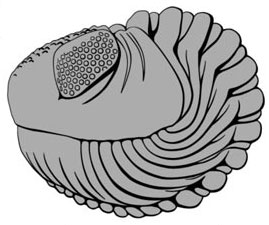|
|
 |
Gilbertsocrinus ohioensis |
Silica formation |
Stan Hyne |
|
Submitted on 2007-09-07 by Stan Hyne
Location (approximate): Sylvania, Lucas, OH
Strat unit: Silica formation
Submitter notes: Prepared by Scott Vergiels
Photo title: Crinoid Crown
Taxa present: Gilbertsocrinus ohioensis
View full record
|
|
|
 |
Unknown |
Silica formation |
Stan Hyne |
|
Submitted on 2007-09-07 by Stan Hyne
Location (approximate): Sylvania, Lucas, OH
Strat unit: Silica formation
Submitter notes:
Photo title: Phyllocarid Mandible
Taxa present: Unknown
View full record
|
|
|
 |
Nucleocrinus meloniformis |
Thunder Bay formation |
David Thompson |
|
Submitted on 2007-03-25 by David Thompson
Location (approximate): Alpena, Alpena, MI
Strat unit: Thunder Bay formation
Submitter notes: This is one of three views of this Nucleocrinus meloniformis (Barris) specimen collected at Partridge Point in Alpena, MI. This is the oral view with a U.S. Ten cent piece for scale. This
large pristine blastoid was just rolling in the water!
Photo title: Thunder Bay Blastoid
Taxa present: Nucleocrinus meloniformis
View full record
|
|
|
 |
Nucleocrinus meloniformis |
Thunder Bay formation |
David Thompson |
|
Submitted on 2007-03-25 by David Thompson
Location (approximate): Alpena, Alpena, MI
Strat unit: Thunder Bay formation
Submitter notes: This is a side view of the Nucleocrinus m. showing Ambulacrum and detail of plates. 10 cent piece for scale. Although collected at Partridge Point, the formation is the Thunder Bay limestone.
Photo title: Second View of Blastoid
Taxa present: Nucleocrinus meloniformis
View full record
|
|
|
 |
Nucleocrinus meloniformis |
Thunder Bay formation |
David Thompson |
|
Submitted on 2007-03-25 by David Thompson
Location (approximate): Alpena, Alpena, MI
Strat unit: Thunder Bay formation
Submitter notes: This is the stem end of the Nucleocrinus m. described in the other two views.
Photo title: Third View of Blastoid
Taxa present: Nucleocrinus meloniformis
View full record
|
|
|
 |
Dolatocrinus Kutasii |
Bell formation |
David Thompson |
|
Submitted on 2007-03-14 by David Thompson
Location (approximate): Rockport, Alpena, MI
Strat unit: Bell formation
Submitter notes: This shows a bit more stem & the arm & pinnules
Photo title: Another view of Bell Shale crinoid
Taxa present: Dolatocrinus Kutasii
View full record
|
|
|
 |
Dolatocrinus kutasii |
Bell formation |
David Thompson |
|
Submitted on 2007-03-14 by David Thompson
Location (approximate): Rockport, Alpena, MI
Strat unit: Bell formation
Submitter notes: This is an example of Dolatocrinus kutasii from the Bell Shale at Rockport, MI This is described in the 'Contributions from the Museum of Paleontolgy' which is available as a link to this website. Dr. Kesling's tongue in cheek description of the finding of the first complete specimen shows some of the enthusiasm he had for collecting. I found this Calyx in 1995 & it was cleaned by Scott Vergiels of the 'Friends'. This does show attached stem & a part of an arm with pinnules.
Photo title: A rare crinoid from the Bell Shale of Rockport, Alpena
Taxa present: Dolatocrinus kutasii
View full record
|
|
|
 |
Cadiscocrinus southworthi |
Arkona formation |
John Topor |
|
Submitted on 2007-03-12 by John Topor
Location (approximate): Arkona, Lambton, ON
Strat unit: Arkona formation
Submitter notes: This crinoid named after a longtime collector from Thedford, Charlie Southworth, is very rare. The species was based on a single calyx that Charlie donated to a museum. This photo shows both a calyx and a small crown. The calyx measures 8mm in height and is 8mm wide at the base. The crown is 17mm high and 11mm wide.
Photo title: Rare Crinoid
Taxa present: Cadiscocrinus southworthi
View full record
|
|
|
 |
Mucrospirifer thedfordensis |
Widder formation |
John Topor |
|
Submitted on 2007-03-12 by John Topor
Location (approximate): Thedford, Lambton, ON
Strat unit: Widder formation
Submitter notes: Three weathered-out examples of this well-known, common brachiopod. In the photo, the top right and bottom specimens show the brachial valve view and the top left shows the pedicle valve view. The largest is 52mm long, and the smallest is 40mm in length.
Photo title: Brachiopods
Taxa present: Mucrospirifer thedfordensis
View full record
|
|
|
 |
Favosites (Emmonsia) arbuscula |
Hungry Hollow formation |
John Topor |
|
Submitted on 2007-03-12 by John Topor
Location (approximate): Arkona, Lambton, ON
Strat unit: Hungry Hollow formation
Submitter notes: These complete specimens were removed from the Hungry Hollow member in several pieces and then glued back together. The right side of the photo shows the base of each coral. The longer specimen measures 125mm. The shorter is about 75mm (not counting the bend). The diameters vary from 12 to 30 plus millimeters.
Photo title: Coral
Taxa present: Favosites (Emmonsia) arbuscula
View full record
|
|
|
 |
Decadocrinus wrightae |
Arkona formation |
John Topor |
|
Submitted on 2007-03-12 by John Topor
Location (approximate): Arkona, Lambton, ON
Strat unit: Arkona formation
Submitter notes: This specimen of Decadocrinus exhibits a complete anal sac and a small portion of arms. This Genus also occurs in the Hungry Hollow and Thedford members of the Widder Formation. The partial crown measures 20mm high and 9mm wide.
Photo title: Crinoid on Matrix
Taxa present: Decadocrinus wrightae
View full record
|
|
|
 |
Leptotrypella quadrangularis |
Arkona formation |
John Topor |
|
Submitted on 2007-03-12 by John Topor
Location (approximate): Arkona, Lambton, ON
Strat unit: Arkona formation
Submitter notes: Bryozoan colonies like this Leptotrypella become established on mature crinoidal lenses. Finding them relatively complete is a rare occurence. In most cases, they have to be reassembled. This colony measures 50mm by 30mm. The overall slab measures 75mm by 80mm.
Photo title: Bryozoan Colony
Taxa present: Leptotrypella quadrangularis
View full record
|
|
|
 |
Mucrospirifer arkonensis |
Arkona formation |
John Topor |
|
Submitted on 2007-03-12 by John Topor
Location (approximate): Arkona, Lambton, ON
Strat unit: Arkona formation
Submitter notes: Pictured are five individual brachiopods. The top and the two left specimens show the brachial valve. The two brachiopods on the right show the pedicle valve view. They are a very common index fossil of the Arkona Formation. They were capable of living in the soft, muddy substrate. Most are flattened. These 3D specimens are uncommon in the formation. The five brachiopods range in size from 65 to 75 millimeters long.
Photo title: Brachiopods
Taxa present: Mucrospirifer arkonensis
View full record
|
|
|
 |
Mucrospirifer arkonensis |
Arkona formation |
John Topor |
|
Submitted on 2007-03-12 by John Topor
Location (approximate): Arkona, Lambton, ON
Strat unit: Arkona formation
Submitter notes: The top specimen on this slab of two Mucrospirifers is in living position. The broken, dispersed shell material below the brachiopod allows for other animals to establish themselves on the muddy sea floor. The length of the brachiopod in living position is about 6cm.
Photo title: Brachiopod in Living Position
Taxa present: Mucrospirifer arkonensis
View full record
|
|
|
 |
Devonoblastus whiteavesi |
Hungry Hollow formation |
John Topor |
|
Submitted on 2007-03-12 by John Topor
Location (approximate): Thedford, Lambton, ON
Strat unit: Hungry Hollow formation
Submitter notes: From the left in the photo, three different blastoid thecas showing the basal, side and summit views of the Genus, Devonoblastus. The height of these specimens ranges from 15 to 18 millimeters.
Photo title: Blastoid Theca
Taxa present: Devonoblastus whiteavesi
View full record
|
|
|
 |
Eutaxocrinus wideneri |
Silica formation |
David Thompson |
|
Submitted on 2007-03-09 by David Thompson
Location (approximate): Sylvania, Lucas, OH
Strat unit: Silica formation
Submitter notes: This Flexible crinoid from the Sylvania Silica formation is a good size for this species. These are not common. Ten Cent piece & fingers are for scale.
Photo title: Silica Crinoid
Taxa present: Eutaxocrinus wideneri
View full record
|
|
|
 |
Megistocrinus rugosus |
Four Mile Dam formation |
David Thompson |
|
Submitted on 2007-03-09 by David Thompson
Location (approximate): Alpena, Alpena, MI
Strat unit: Four Mile Dam formation
Submitter notes: This shows the tegmen of the previous Megistocrinus rugosus with the red replacement. Traces of red are found in fossils near the bioherms but rarely a complete calyx with this much. U.S. Ten Cent piece for scale
Photo title: The tegmen of 'red' crinoid
Taxa present: Megistocrinus rugosus
View full record
|
|
|
 |
Megistocrinus rugosus |
Four Mile Dam formation |
David Thompson |
|
Submitted on 2007-03-09 by David Thompson
Location (approximate): Alpena, Alpena, MI
Strat unit: Four Mile Dam formation
Submitter notes: This example of Megistocrinus rugosus crinoid caylx shows how at times mineral replacement can be of a rich red Calcite, making a nice fossil more attractive. This was collected at a bioherm or fossil 'reef' in a quarry. This shows the stem base, the upper tegman is complete also.
Photo title: A 'carnelian' crinoid from Alpena
Taxa present: Megistocrinus rugosus
View full record
|
|
|
 |
Heliophyllum halli, Petrocrania hamiltoniae, Cystiphyllum |
Widder formation |
David Thompson |
|
Submitted on 2007-03-09 by David Thompson
Location (approximate): Thedford, Lambton, ON
Strat unit: Widder formation
Submitter notes: Two different species of horn corals from Arkona & Thedford, Ontario that have the distinct 'scar'
of attachment, the bottom valve of the inarticulate braciopod, Petrocrania hamiltoniae, clearly showing. The coral on the left is probablly Cystiphyllum sp.? while the one on the right is Heliophyllum halli. A U.S. Ten Cent piece is for scale. The top valve of the Inarticulate is missing showing the interior muscle scars.
Photo title: Horn Corals with inarticulate attachments
Taxa present: Heliophyllum halli, Petrocrania hamiltoniae, Cystiphyllum
View full record
|
|
|
 |
Microcyclus thedfordensis, Pleurodictyum (procteria) cornu |
Silica formation |
David Thompson |
|
Submitted on 2007-03-08 by David Thompson
Location (approximate): Milan, Washtenaw, MI
Strat unit: Silica formation
Submitter notes: This image compares the structure & size of Microcyclus thedfordensis with the small corals, Pleurodictyum (Procteria) cornu from the Michigan Silica formation. A. is an example of the Microcyclus from the Thedford area of Ontario, B. shows three examples of the Pleurodictyum, two with the upper multi-coralite side showing & the third showing the under side of another example. Unlike the Microcyclus, the Pleurodictyum does not start by attaching to anything. C. is a slightly larger example of the Pleurodictyum from the Bell Shale in Rockport, MI. Mike Toper has other examples on this site of Microcyclus. The U.S. ten cent piece is for scale.
Photo title: Tiny coralites
Taxa present: Microcyclus thedfordensis, Pleurodictyum (procteria) cornu
View full record
|










































